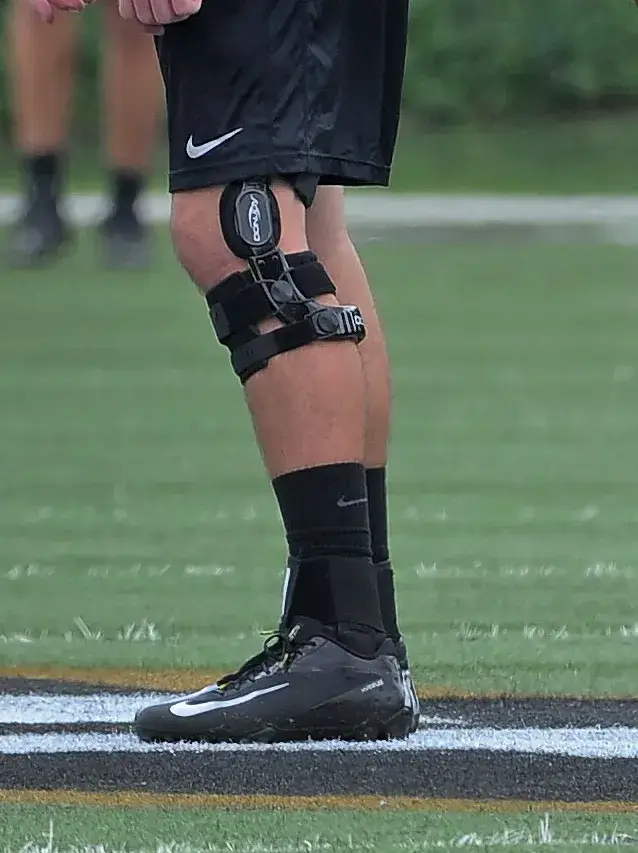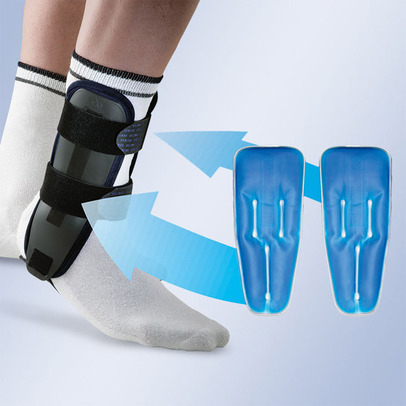Football is an exhilarating sport that demands physical strength, agility, and resilience. Athletes often encounter various injuries, and one common area prone to injury is the knee. To mitigate the risk of knee-related issues and support players during their recovery, knee braces have become an integral part of football equipment. In this article, we will explore when to use knee braces in football, their benefits, and how to wear them effectively.
Table: Best Football Knee Brace in 2023
1. DonJoy Performance Bionic Knee Brace
The DonJoy Performance Bionic Knee Support Brace stands out as an excellent choice for football players due to its array of features tailored to meet their needs. Its bilateral polycentric hinges with hyperextension stops provide essential support for knee instability, crucial in the high-impact nature of the sport. The top and bottom stretch webbing closure, featuring TPR pull tabs, ensures a precise and comfortable fit, facilitating quick and hassle-free wear. This brace’s wrap-around design enhances comfort and convenience. Thanks to anti-migration technology, slipping becomes a thing of the past, while the perforated neoprene material ensures optimal breathability. Additionally, the inclusion of reflectivity enhances visibility in low-light conditions, making it a reliable companion for football players on and off the field.
2. Fla 37-103MDBLK Knee Brace
The Fla 37-103MDBLK Knee Brace, part of the Safe-T-Sport Stabilizing Knee Support series, emerges as an ideal choice for football players seeking enhanced knee support. Its standout feature is the removable horseshoe insert, strategically designed to bolster patellar support, a critical requirement in football’s high-impact scenarios. Crafted from sports neoprene, this brace offers both compression and therapeutic warmth, promoting joint stability. The built-in spiral stays contribute further to stability, crucial for preventing injuries on the field. With two adjustable straps ensuring a secure fit, it stays firmly in place during rigorous play. Whether in navy or black, this knee brace, designed to fit either the right or left knee, measures precisely 4 inches above the center of the knee, making it a reliable companion for football players looking to protect and support their knees during intense matches.
3. Mueller Sports Medicine Hinged Knee Brace
The Mueller Sports Medicine Hinged Knee Brace emerges as a valuable asset for football players owing to its versatile support capabilities. It’s designed to offer essential reinforcement to weak, injured, or arthritic knees, effectively preventing both medio-lateral movement and hyperextension—common risks on the football field. With its one-size-fits-most design and adaptable tension straps, this brace caters to a range of sizes, ensuring optimal compression and support. Its geared hinges play a pivotal role in controlling unwanted motion, ensuring proper leg movement and stability. The open-back design enhances comfort by eliminating bunching, while adjustable sizing pockets provide customized support. Additionally, the fabric treatment prevents odor buildup, maintaining a fresh feel during intense play. As a product from the trusted Mueller Sports Medicine brand, with a legacy spanning over 60 years, this knee brace is a reliable choice for football players committed to reducing pain and enhancing performance on the field.
4. DonJoy BIONIC FULLSTOP ACL – FOR HARD INJURIES
The DonJoy Performance BIONIC FULLSTOP ACL Knee Brace is an invaluable asset for football players dealing with severe injuries, thanks to its advanced features tailored to address such challenges. Employing cutting-edge hinge technology and a four-point leverage system, it effectively trains users to avoid the “at-risk” position, providing critical support during the intense and often risky plays in football. Furthermore, its compression and thermal heat regulation capabilities ensure players remain at an optimal temperature, preventing overheating during strenuous matches. The anti-migration technology ensures that the sleeve stays securely in place. The adjustable straps offer a personalized, secure fit, and the added reflectivity enhances visibility in low-light conditions, which is essential for evening games or practices. Designed to treat and protect ACL and meniscus injuries, joint instabilities, and various ligament and tendon sprains, this brace is a go-to solution for football players and athletes in similar high-impact sports who demand the highest level of support and protection for their knees.
Benefits of Using Knee Brace in Football
A knee brace is a medical device designed to provide support, stability, and protection to the knee joint. It is typically made of a combination of rigid or semi-rigid materials such as metal, plastic, or composite materials, along with adjustable straps or fasteners.
- Increased Stability: Knee braces offer enhanced stability to the knee joint, reducing the chances of ligament sprains, strains, or tears. They provide support to the ligaments and tendons surrounding the knee, promoting proper alignment and reducing the risk of lateral or rotational injuries.
- Pain Relief: Knee braces can help alleviate pain caused by conditions like patellar tendonitis, arthritis, or mild ligament sprains. The compression and support provided by knee braces can help reduce inflammation and discomfort, allowing players to perform at their best.
- Confidence and Psychological Support: Wearing a knee brace can provide psychological support to players who have previously experienced knee injuries. The added stability and protection can boost confidence, enabling athletes to play more aggressively without fearing reinjury.
Most Common Injuries in Football
The most common knee injuries in football are typically anterior cruciate ligament (ACL) tears, medial collateral ligament (MCL) sprains, and meniscus tears. ACL tears often occur due to sudden changes in direction or awkward landings, and they can be season-ending injuries. MCL sprains result from impact to the outer knee and can range from mild to severe. Meniscus tears are frequently the result of twisting or pivoting motions and can lead to pain and limited mobility. Additionally, patellar tendonitis, also known as jumper’s knee, is common in football players due to the repetitive strain on the knee joint during jumping and sprinting activities. Proper conditioning, warm-up routines, and protective gear are essential to reduce the risk of these injuries in football.
Furthermore, football players may also experience other knee injuries such as patellar dislocations or fractures, as well as overuse injuries like iliotibial band syndrome (ITBS) or pes anserinus tendonitis. Patellar dislocations can happen when the kneecap is forced out of its normal position, causing severe pain and instability. Fractures typically result from high-impact collisions and can be serious injuries requiring surgical intervention. ITBS and pes anserinus tendonitis are often associated with repetitive running and can cause pain on the outer and inner sides of the knee, respectively. Given the physical demands of football, injury prevention strategies, including strength training, flexibility exercises, and proper technique, are crucial for players to minimize the risk of these common knee injuries and maintain their overall performance and longevity in the sport.
When to Use a Knee Brace in Football
- Prevention of Injuries: Knee braces are commonly used as a preventive measure to minimize the risk of knee injuries during football activities. Athletes who have a history of knee problems or those involved in high-impact positions like linebackers or linemen may choose to wear knee braces for added stability.
- Rehabilitation: Following a knee injury or surgery, athletes may use knee braces to support their recovery process. Knee braces provide stability to the injured area, alleviate pain, and facilitate healing. It’s crucial to consult with a healthcare professional to determine the appropriate time to wear a knee brace during rehabilitation.
How to Wear a Knee Brace
- Choose the Right Brace: Consult with a healthcare professional to determine the appropriate knee brace for your specific condition or requirements. There are different types of knee braces available, including prophylactic (preventive), functional (supportive), and rehabilitative braces.
- Follow Instructions: Read and understand the manufacturer’s instructions that come with the knee brace. It’s crucial to wear the brace as intended, ensuring proper fit and support.
- Proper Positioning: Position the knee brace correctly over the knee joint, ensuring it covers the desired area. Fasten the straps securely, but not too tight, to maintain comfort and flexibility.
- Range of Motion: Some knee braces restrict the range of motion while others allow for more movement. Choose the appropriate brace that suits your needs, depending on the level of support required and the recommendations of your healthcare professional.
- Regular Maintenance: Keep your knee brace clean and in good condition by following the manufacturer’s maintenance instructions. Regularly inspect the brace for any signs of wear and tear, and replace it if necessary.
Conclusion
Knee braces have become indispensable for football players, providing stability, support, and protection to the knee joint. Whether as a preventive measure or during the rehabilitation process, knee braces offer numerous benefits. When considering a knee brace, consult with a healthcare professional to determine the appropriate type and usage. By wearing knee braces correctly and following proper guidelines, football players can reduce the risk of knee injuries and perform at their best on the field.
FAQ
- How can a knee brace benefit football players?
- A knee brace can provide stability and support to the knee joint, reducing the risk of injuries or helping players recover from existing knee issues. It can also offer confidence and peace of mind during intense physical activities like football.
- Are knee braces mandatory in football?
- Knee braces are typically not mandatory in football. However, some players with a history of knee problems or those recovering from injuries may choose to wear them for added protection and support.
- Can wearing a knee brace restrict my mobility on the field?
- While knee braces are designed to provide support, modern designs aim to minimize restrictions on mobility. It’s important to select the right type of knee brace and ensure it fits properly to maintain a good range of motion while playing.
- How do I choose the right knee brace for football?
- The choice of a knee brace depends on your specific needs. Consult with a sports medicine professional or orthopedic specialist to determine the appropriate type (e.g., hinged, sleeve, or wraparound) and size of knee brace for your condition or prevention goals.
- Can I wear a knee brace over or under my football pants?
- Knee braces are typically worn underneath football pants to ensure a secure fit and prevent discomfort or interference with your uniform. However, it’s essential to follow your team’s guidelines and league rules regarding equipment and uniform regulations.









Youre so cool! I dont suppose Ive learn something like this before. So nice to seek out any person with some original ideas on this subject. realy thanks for starting this up. this website is something that is wanted on the internet, someone with a bit originality. useful job for bringing one thing new to the web!